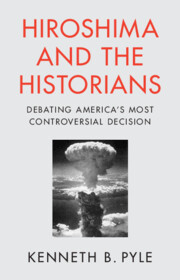Book contents
- Hiroshima and the Historians
- Hiroshima and the Historians
- Copyright page
- Dedication
- Contents
- Figures
- Acknowledgments
- Note on the Text
- Introduction
- 1 The Historian’s Craft
- 2 The Hiroshima Decision
- 3 Participants and Their First Draft of History
- 4 The Revisionists
- 5 Historians and Moral Judgments
- 6 Military Historians
- 7 Gauging Japanese Responsibility
- 8 A Wider Perspective
- 9 Controversy as a Way of Life
- Suggestions for Further Reading
- Book part
- Index
3 - Participants and Their First Draft of History
Published online by Cambridge University Press: 30 May 2024
- Hiroshima and the Historians
- Hiroshima and the Historians
- Copyright page
- Dedication
- Contents
- Figures
- Acknowledgments
- Note on the Text
- Introduction
- 1 The Historian’s Craft
- 2 The Hiroshima Decision
- 3 Participants and Their First Draft of History
- 4 The Revisionists
- 5 Historians and Moral Judgments
- 6 Military Historians
- 7 Gauging Japanese Responsibility
- 8 A Wider Perspective
- 9 Controversy as a Way of Life
- Suggestions for Further Reading
- Book part
- Index
Summary
Makers of history want historians to treat them favorably. Those who wield power often wish to influence the way in which history will view them. They are concerned about securing their place in history. This chapter explores how participants in the decision to use the bomb, provoked by criticism and worried about how historians would treat them, explained and justified their decision. The impact of John Hersey’s bestselling Hiroshima and other writing critical of the use of the bomb deeply troubled participants in the decision. They instigated Henry Stimson’s Harper’s 1947 article “The Decision to Use the Atomic Bomb,” which defended the decision as necessary to avoid an invasion, bring the war to an early end, and save American and Japanese lives. Despite its shortcomings, Stimson’s defense stood for two decades as the largely unchallenged interpretation of the use of the bomb and became the foundation of the “orthodox interpretation” which still remains a widely held view.
Keywords
- Type
- Chapter
- Information
- Hiroshima and the HistoriansDebating America's Most Controversial Decision, pp. 61 - 90Publisher: Cambridge University PressPrint publication year: 2024

